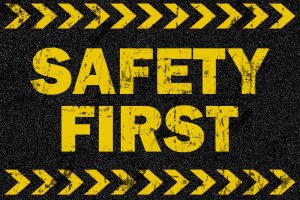What are you doing to keep your Small Business safe during National Safety Month?
June is National Safety Month. According to the National Safety Council, ‘National Safety Month focuses on reducing leading causes of injury and death at work, on the road and in our homes and communities’. Saving lives is the first and foremost goal of National Safety Month, but there are many more ways a business can benefit from a safe work environment. Safety leads to less frequent and less severe injuries to employees. It also leads to less loss to equipment and property owned by a business. Plain and simple, in most cases a safe business is a profitable business. Here are some facts and figures to show you why your small business should participate in National Safety Month and implement the information you find out about a safe work environment into your organization throughout the rest of the year.

Why is safety important?
Safety may seem like an obvious important aspect to any business, but when bills start pouring in safety may take a backseat to other issues. This is a very short-sighted view to take as a small business owner. Especially considering the substantial cost just one severe workers compensation claim can have on a business.
What is most important to implement?
Slips, Trips, and Falls are the number one reason a business has to file an insurance claim. Especially businesses that have high traffic like a restaurant. Because of the frequency of these claims, your managers and key employees should periodically take time to prevent these occurrences from happening in the first place. Slips, trips, and falls and not the most severe injuries. The most severe injuries typically take place related to heavy lifting, employees working at height, and car accidents. If you have employees who engage in any of these activities, it is important to address these risks head on and make it a regular part of your business to prevent severe injuries.
Where do we go from here?
National Safety Week is designed to bring attention to the importance of safety in the workplace. This exercise is not something a business should celebrate one month a year and quickly go back to old habits after the Independence Day Holiday Festivities take place. Using this time to get with key employees within your company to design or update your safety programs is the best way to benefit throughout the year. After this designing or updating of your organizations safety programs it is important to carve out some time to dedicate to safety on a regular basis. These safety meetings do not have to be long or exhaustive, but they should be regular and documented. This documentation can come in handy with your insurance carrier when you have a year in which you have several claims or one large claim. This documentation can be used by you and your insurance agent to show that you have the proper policies in place to make sure the issue does not become an ongoing problem.
One perfect reminder in the not so distant future is the Safe+Sound Week, which kicks off on August 13. This is a nationwide event led by OSHA to bring awareness and understanding to the value of safety and health programs. OSHA wants to include management, worker participation, and a systematic approach to fixing hazards in the workplace. The Safe+Sound Week is the perfect opportunity for a business to check in and see what improvements they have made to the safety protocols and what areas still need work.
Here are some statistics to show you just how important safety is to any small business.
The following were the top 10 most frequently cited standards by Federal OSHA in fiscal year 2017 (October 1, 2016, through September 30, 2017):
- Fall protection, construction
- Hazard communication standard, general industry
- Scaffolding, general requirements, construction
- Respiratory protection, general industry
- Control of hazardous energy (lockout/tagout), general industry
- Ladders, construction
- Powered industrial trucks, general industry
- Machinery and Machine Guarding, general requirements
- Fall Protection–Training Requirements
- Electrical, wiring methods, components and equipment, general industry
According to a recent survey of small business Employers Insurance, ’17 percent never got any workplace training. For companies with less than 10 employees, that number jumps to 25 percent’.
According to OSHA, 5,190 workers were killed on the job in 2016.
14,803 more people died accidentally in 2016 than in 2015 – a 10 percent year-over-year increase. This is the largest single-year percent rise since 1936.
Overdoses from the use of non-medical drugs and alcohol while on the job increased by 32% from 2016-2017. This ratio has seen a 25% increase each year since 2012.
